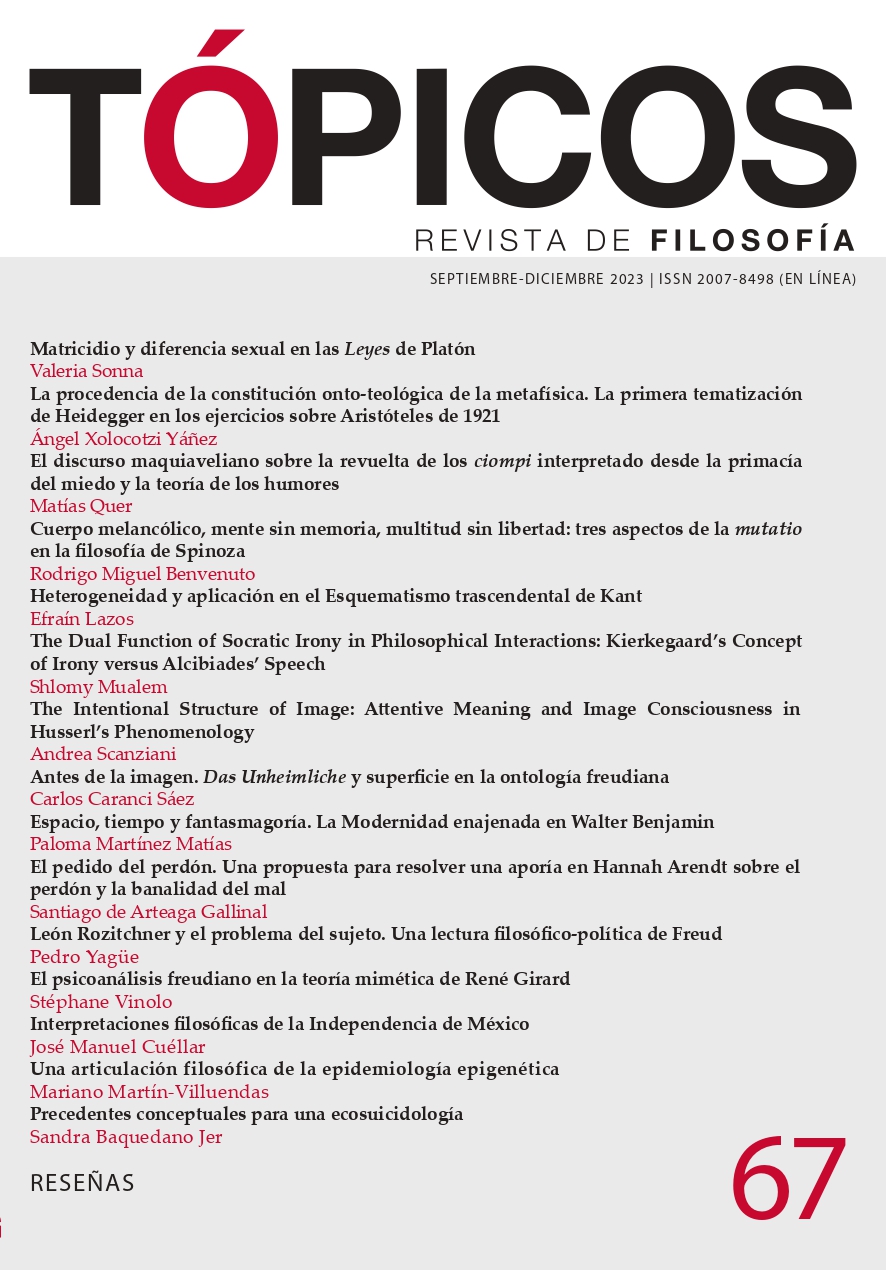The Intentional Structure of Image: Attentive Meaning and Image Consciousness in Husserl’s Phenomenology
Publiée 2023-08-01
Mots-clés
- Husserl,
- image consciousness,
- attentive meaning,
- attention
(c) Copyright Tópicos, Revista de Filosofía 2023

Ce travail est disponible sous licence Creative Commons Attribution - Pas d'Utilisation Commerciale - Pas de Modification 4.0 International.
Comment citer
Résumé
This article considers Edmund Husserl’s description of image consciousness from the viewpoint of the role played by attentive meaning (meinen) in the intention of the image subject. We argue that the intention of the image subject has to be interpreted in the sense of the attentive meaning as presented in the second part of Husserl’s 1904/5 lecture on Phenomenology and Theory of Knowledge. Attentive meaning performs 1) the segregation of a specific apprehension along with the attentive articulation of experience, and 2), as a formative and preferential function, it introduces a difference in the objective consideration. First, we explain the connection between apprehension, attentive meaning, and object; then, we clarify the relationship between apprehension and attentive meaning in image consciousness in the 1898 manuscripts and the 1904 lecture; finally, we set forth the motivation for the intending of the image subject on the basis of the image apprehension.
Références
- Bégout, B. (2007). Husserl and the Phenomenology of Attention. In L. Boi, P. Kerszberg, & F. Patras (eds.), Rediscovering Phenomenology. Phenomenological Essays on Mathematical Beings, Physical Reality, Perception and Consciousness. (pp. 13-32). Springer.
- Bernet, R. (2004). Conscience et existence. Perspectives phénoménologiques. PUF.
- Breyer, T. (2011). Attentionalität und Intentionalität. Wilhelm Fink.
- Brough, J. (1992). Some Husserlian Comments on Depiction and Art. American Catholic Philosophical Quarterly, 66(2), 241-259. DOI: https://doi.org/10.5840/acpq199266233.
- Brough, J. (1999). Cuts and Bonds: Husserl’s Systematic Investigation of Representation. Philosophy Today, 43, 115-23. DOI: https://doi.org/10.5840/philtoday199943Supplement55.
- Chasid, A. (2014). Pictorial Experience: Not So Special After All. Philosophical Studies, 171, 471-491. DOI: https://doi.org/10.1007/s11098-014-0279-y.
- Cometti, J. P. (2002). Merleau-Ponty, Wittgenstein, and the Question of Expression. Revue internationale de philosophie, 1, 73-89.
- Depraz, N. (2009). Introduction. In E. Husserl, Phénoménologie de l’attention. (pp. 7-62). Vrin.
- De Warren, N. (2010). Tamino’s Eyes, Pamina’s Gaze: Husserl’s Phenomenology of Image-Consciousness Refashioned. In F. Mattens, H. Jacobs, & C. Ierna (eds.), Philosophy, Phenomenology, sciences: Essays in Commemoration of Edmund Husserl. (pp. 303-332). Springer.
- De Warren, N. (2012). The Third Life of Subjectivity: Towards a Phenomenology of Dreaming. In R. Breeur & U. Melle (eds.), Life, Subjectivity & Art. Essays in Honor of Rudolf Bernet. (pp. 457-479). Springer.
- Eldridge, P. (2017). Depicting and Seeing-in. The ‘Sujet’ in Husserl Phenomenology of Images. Phenomenology and the Cognitive Sciences, 17, 555-578.
- Ferencz-Flatz, C. (2009a). Gibt es perzeptive Phantasie? Als-ob-Bewusstsein, Widerstreit und Neutralität in Husserls Aufzeichnungen zur Bildbetrachtung. Husserl Studies, 25(3), 235-253. DOI: https://doi.org/10.1007/s10743-009-9062-x.
- Ferencz-Flatz, C. (2009b). The Neutrality of Images and Husserlian Aesthetics. Studia Phaenomenologica, 9, 477-493.
- Husserl, E. (1979). Aufsätze und Rezensionen. Husserliana XXII. B. Rang (ed.). Martinus Nijhoff.
- Husserl, E. (1980). Phantasie, Bildbewusstsein, Erinnerung. Huserliana XXIII. E. Marbach (ed.). Kluwer.
- Husserl, E. (1991). On The Phenomenology of The Consciousness of Internal Time (1893-1917). J. B. Brough (trans.). Kluwer.
- Husserl, E. (1998). Ideas Pertaining to a Pure Phenomenology and to a Phenomenological Philosophy. First Book. F. Kersten (ed.). Kluwer.
- Husserl, E. (2001a). Logical Investigations. Volume 1. J. N. Findlay (trans.). Routledge.
- Husserl, E. (2001b). Logical Investigations. Volume 2. J. N. Findlay (trans.). Routledge.
- Husserl, E. (2004). Wahrnehmung und Aufmerksamkeit. Husserliana XXXVIII. T. Vongehr & R. Giuliani (eds.). Springer.
- Husserl, E. (2005). Phantasy, Image Consciousness and Memory (1898-1925). J. B. Brough (trans.). Springer.
- Husserl, E. (2020). Studien zur Struktur des Bewusstseins. Husserliana XLIII/1. U. Melle & T. Vongehr (eds.). Springer.
- Jacquette, D. (2016). Art, Expression, Perception, and Intentionality. Journal of Aesthetics and Phenomenology, 1(1), 63-90. DOI: https://doi.org/10.2752/20539339XX14005942183973.
- Kurg, R.-N. (2014). Edmund Husserl’s Theory of Image Consciousness, Aesthetic Consciousness, and Art. [Doctoral dissertation]. University of Fribourg. URL: https://core.ac.uk/download/pdf/43660823.pdf.
- Kurg, R.-N. (2018). Phantasms and Physical Imagination in Husserl’s Theory of Pictorialization. Anuario Filosófico, 51(2), 325-345. DOI: https://doi.org/10.15581/009.51.2.325-345.
- Liu, C. (2019). Prinzipien und Grundlagen der Wahrnehmungsauffassung bei Husserl. Husserl Studies, 35(2), 149-176.
- Lohmar, D. (1993). Grundzüge eines Synthesis-Modells der Auffassung: Kant und Husserl über den Ordnungsgrad sinnlicher Vorgegebenheiten und die Elemente einer Phänomenologie der Auffassung. Husserl Studies, 10(2), 111-141.
- Lories, D. (2006). Remarks on Aesthetic Intentionality: Husserl or Kant. International Journal of Philosophical Studies, 14(1), 31-49. DOI: https://doi.org/10.1080/09672550500445103.
- Lotz, C. (2010). Im Bilde Sein. Husserls Phänomenologie des Bildbewusstseins. In R. Veressov & S. Neuber (eds.), Das Bild als Denkfigur. Funktionen des Bildbegriffs in der Philosophiegeschichte von Platon bis Nancy. (pp. 167-181). Wilhelm Fink.
- Orth, E. W. (1999). Edmund Husserls „Krisis der europäischen Wissenschaften und die transzendentale Phänomenologie”. Wissenschaftliche Buchgesellschaft.
- Rozzoni, C. (2017). From Abbild to Bild? Depiction and Resemblance in Husserl’s Phenomenology. Aisthesis, 1(1), 117-130. URL: https://doi.org/10.13128/Aisthesis-20912.
- Shum, P. (2015). The Evolution and Implications of Husserl’s Account of the Imagination. Husserl Studies, 31 (3), 213-236. DOI: https://doi.org/10.1007/s10743-015-9175-3.
- Volonté, P. (1997). Husserls Phänomenologie der Imagination. Alber.
- Wiesing, L. (1996). Phänomenologie des Bildes nach Husserl und Sartre. Phänomenologische Forschungen, 30, 255-281.
- Wiesing, L. (2010). Artificial Presence: Philosophical Studies in Image Theory. Stanford University Press.
- Wollheim, R. (1987). Painting as an Art. Princeton University Press.





